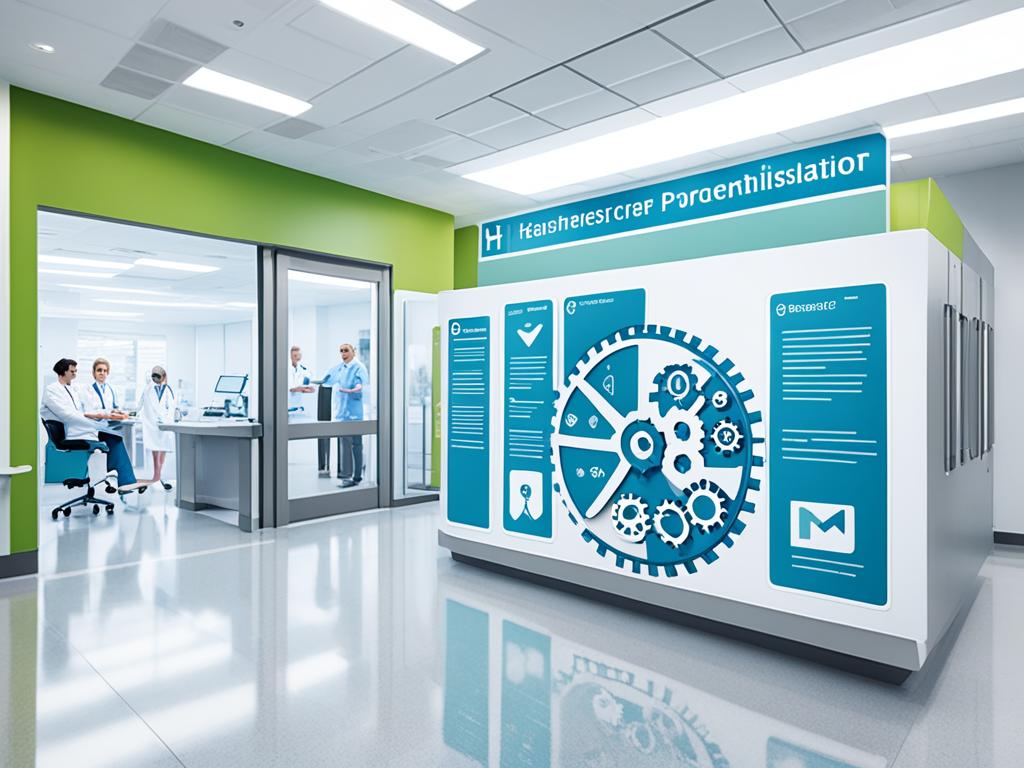- 1. Understanding Operational Efficiency in Healthcare
- 2. Process Optimization: Key to Improving Efficiency
- 3. Strategies for Enhancing Operational Efficiency
- 4. Healthcare Management and Administration
- 5. The Role of Technology in Operational Efficiency
- 6. Change Management and Staff Engagement
- 7. Measuring and Monitoring Operational Efficiency
- 8. Regulatory Compliance and Patient Safety
- 9. Conclusion
- 10. FAQ
- 10.1 What is operational efficiency in healthcare?
- 10.2 Why is operational efficiency important in healthcare?
- 10.3 What are the key strategies for enhancing operational efficiency in healthcare facilities?
- 10.4 How can technology help improve operational efficiency in healthcare?
- 10.5 What is the role of healthcare management and administration in improving operational efficiency?
- 10.6 How important is change management and staff engagement in implementing operational efficiency strategies?
- 10.7 How can healthcare organizations measure and monitor their operational efficiency?
- 10.8 How do regulatory compliance and patient safety factor into operational efficiency in healthcare?
- 11. Source Links
Operational efficiency is crucial in the healthcare industry for providing high-quality patient care, reducing costs, and improving overall organizational performance. With healthcare costs continuing to rise, healthcare organizations must find ways to improve efficiency and reduce waste without compromising patient care. By implementing proven strategies in healthcare management and administration, healthcare leadership, hospital administration, clinical operations, patient care coordination, healthcare compliance, healthcare finance, healthcare informatics, quality assurance in healthcare, healthcare human resources, healthcare operations, healthcare quality assurance, healthcare marketing, and healthcare strategic planning, organizations can streamline operations, optimize resources, and deliver superior patient care with increased efficiency. This article will explore practical tips and strategies for enhancing operational efficiency in healthcare facilities.
Key Takeaways:
- Operational efficiency is crucial for providing high-quality patient care, reducing costs, and improving overall organizational performance in healthcare.
- Healthcare organizations must find ways to improve efficiency and reduce waste without compromising patient care.
- Implementing proven strategies in healthcare management and administration can help streamline operations, optimize resources, and deliver superior patient care.
- This article will explore practical tips and strategies for enhancing operational efficiency in healthcare facilities.
- The article will cover topics such as process optimization, technology integration, change management, and performance monitoring.
Understanding Operational Efficiency in Healthcare
Operational efficiency is a critical aspect of healthcare management and administration, as it directly impacts the quality of patient care, the productivity of healthcare operations, and the overall financial well-being of healthcare organizations. In the dynamic and ever-evolving healthcare landscape, understanding the definition and importance of operational efficiency is paramount for healthcare providers and administrators to enhance their organization’s performance and deliver superior patient outcomes.
Definition and Importance of Operational Efficiency
Operational efficiency in healthcare refers to the ability of a healthcare organization to produce high-quality services and patient care with the minimum amount of resources and waste possible. It is the ratio of output (in terms of patient care and clinical outcomes) to input (in terms of time, money, and other resources) within the healthcare system. Operational efficiency is particularly crucial in healthcare, as it can have a significant impact on patient outcomes, patient satisfaction, and the overall financial viability of the organization.
Impact on Patient Outcomes and Cost Management
By optimizing healthcare processes and workflows, healthcare providers can improve patient flow, reduce wait times, and help patients receive timely, high-quality care. This, in turn, can lead to better patient outcomes and increased patient satisfaction. Additionally, improved operational efficiency can result in cost savings for healthcare organizations by reducing waste, maximizing productivity, and streamlining administrative processes. This allows healthcare organizations to allocate resources more effectively and focus on delivering the best possible care to their patients.
Process Optimization: Key to Improving Efficiency
Streamlining healthcare processes is a crucial aspect of enhancing operational efficiency. Process optimization involves identifying areas for improvement in the workflows and procedures used to deliver patient care, and then making strategic changes to optimize those processes. The primary goal of process optimization is to reduce waste, enhance patient outcomes, and increase overall efficiency within healthcare facilities.
Leveraging Technology in Process Optimization
One key component of process optimization is the strategic integration of healthcare technology. Tools such as electronic health records (EHRs), telemedicine platforms, and other digital solutions can help automate processes, reduce errors, and improve communication and collaboration among healthcare providers. By harnessing the power of technology, healthcare organizations can streamline their workflows and enhance their ability to deliver high-quality care efficiently.
Optimizing Workflows and Reducing Administrative Burdens
In addition to leveraging technology, healthcare facilities can also improve efficiency by optimizing their internal workflows and reducing administrative burdens. This may involve streamlining patient intake and discharge procedures, automating repetitive tasks, and finding ways to minimize the time healthcare providers spend on non-clinical paperwork and documentation. By optimizing workflows and reducing administrative burdens, healthcare organizations can free up resources, enhance patient experiences, and focus more on delivering exceptional care.

Strategies for Enhancing Operational Efficiency
Healthcare organizations can employ various strategies to enhance their operational efficiency. These include standardizing processes, improving communication and collaboration among teams, and continuously monitoring and improving operational processes.
Standardizing Processes and Implementing Best Practices
Standardizing processes can help reduce variation and improve efficiency. By creating standard workflows, procedures, and guidelines, healthcare providers can reduce errors and improve patient outcomes. Implementing industry best practices can also contribute to healthcare process standardization, leading to increased healthcare operational efficiency.
Improving Communication and Collaboration Among Teams
Effective communication and collaboration among healthcare providers can help reduce errors, improve patient outcomes, and increase healthcare operational efficiency. By using digital tools and other communication methods, healthcare teams can work more effectively and efficiently, fostering a culture of healthcare team collaboration.
Continuous Monitoring and Process Improvement
Continuously monitoring and analyzing operational processes can help identify areas where further improvements can be made. By regularly evaluating and optimizing processes, healthcare providers can operate at peak efficiency, embracing a mindset of healthcare continuous improvement.
| Strategy | Key Benefits |
|---|---|
| Healthcare process standardization | Reduces variation, improves efficiency, and enhances patient outcomes |
| Healthcare team collaboration | Reduces errors, improves patient outcomes, and increases operational efficiency |
| Healthcare continuous improvement | Identifies areas for improvement and helps healthcare providers operate at peak efficiency |
Healthcare Management and Administration
Effective
healthcare management and administration
play a crucial role in enhancing operational efficiency. Key strategies include optimizing resources and workforce allocation, as well as enhancing care coordination and patient flow.
Optimizing Resources and Workforce Allocation
Healthcare organizations can improve efficiency by ensuring that resources, including staff, equipment, and supplies, are allocated effectively to meet the demands of patient care. This involves carefully analyzing patient volumes, staffing needs, and equipment utilization to ensure that resources are deployed where they are needed most. By optimizing resource allocation, healthcare providers can reduce waste, improve productivity, and deliver better patient outcomes.
Enhancing Care Coordination and Patient Flow
Improving care coordination among different healthcare providers and departments can enhance patient flow, reduce wait times, and improve the overall patient experience. This can involve streamlining communication, implementing digital tools for care coordination, and fostering collaboration among healthcare teams. By enhancing patient flow and reducing bottlenecks, healthcare organizations can deliver more efficient and effective care to their patients.

The Role of Technology in Operational Efficiency
Technology plays a pivotal role in enhancing operational efficiency within the healthcare industry. By leveraging innovative healthcare technology solutions, healthcare organizations can streamline their processes, improve patient care, and optimize resource utilization.
Electronic Health Records (EHRs) and Healthcare Digital Tools
Electronic Health Records (EHRs) and other healthcare digital tools have become indispensable in improving operational efficiency. These technologies can help automate administrative tasks, reduce errors, and enhance communication and collaboration among healthcare providers. By digitizing patient records and integrating them with clinical workflows, healthcare organizations can access critical patient data more efficiently, leading to better-informed decision-making and improved patient outcomes.
Telemedicine and Remote Patient Monitoring
The adoption of telemedicine and remote patient monitoring technologies has been a game-changer in enhancing healthcare operational efficiency. These technologies enable healthcare providers to offer virtual consultations, monitor patients remotely, and provide care to patients in their own homes or communities. This not only improves access to care but also reduces the need for in-person visits, ultimately optimizing patient flow and resource utilization within healthcare facilities.
Data Analytics and Healthcare Business Intelligence
Leveraging data analytics and business intelligence tools can provide healthcare organizations with valuable insights into their operational processes. By collecting, analyzing, and interpreting data from various sources, such as EHRs, billing systems, and patient feedback, healthcare leaders can identify areas for improvement, optimize resource allocation, and make data-driven decisions to enhance overall operational efficiency.
Change Management and Staff Engagement
Successful implementation of
healthcare change management
and
healthcare staff engagement
strategies is crucial for enhancing operational efficiency in healthcare facilities. Two key elements to consider are effective communication and training, as well as involving staff in process improvement initiatives.
Effective Communication and Training
Communicating changes clearly to healthcare staff and providing them with the necessary healthcare training is essential for ensuring the successful adoption of new processes and technologies. By keeping employees informed and equipping them with the right knowledge and skills, healthcare organizations can facilitate a smooth transition and drive sustained improvements in healthcare communication and operational efficiency.
Involving Staff in Process Improvement Initiatives
Engaging frontline healthcare staff in identifying and implementing healthcare process improvement initiatives can foster a culture of continuous improvement and increase buy-in from employees. By empowering staff to contribute their insights and expertise, healthcare organizations can tap into valuable on-the-ground knowledge and foster a shared sense of ownership, leading to more effective and sustainable operational efficiency initiatives.

Measuring and Monitoring Operational Efficiency
Measuring and monitoring operational efficiency is essential for healthcare organizations to identify areas for improvement and track their progress. By establishing and tracking key performance indicators (KPIs) and metrics, as well as engaging in benchmarking and best practice sharing, healthcare leaders can gain valuable insights to drive continuous optimization.
Key Performance Indicators (KPIs) and Metrics
Establishing and tracking relevant KPIs and metrics is a crucial step in enhancing healthcare operational efficiency. Some key healthcare KPIs to consider include patient wait times, staff productivity, cost per patient encounter, and patient satisfaction scores. These metrics can provide valuable insights into the efficiency of various operational processes, enabling healthcare leaders to identify bottlenecks, optimize resource allocation, and make data-driven decisions.
Benchmarking and Best Practice Sharing
Comparing an organization’s performance against industry healthcare benchmarks and actively sharing healthcare best practices with peers can also be highly effective in improving operational efficiency. By understanding how their organization’s performance stacks up against industry standards, healthcare leaders can pinpoint areas where they excel and identify opportunities for further optimization. Additionally, by collaborating with other healthcare providers and sharing successful strategies, organizations can adopt proven tactics to enhance their own operational efficiency.
| Key Performance Indicator | Metric | Benchmark |
|---|---|---|
| Patient Wait Time | Average time from check-in to provider visit | 20 minutes or less |
| Staff Productivity | Patients seen per hour per provider | 3-5 patients per hour |
| Cost per Patient Encounter | Total operating costs divided by number of patient encounters | $150-$250 per encounter |
| Patient Satisfaction | Net Promoter Score (NPS) | 70 or higher |
By consistently measuring and monitoring these key performance indicators and benchmarking their performance against industry standards, healthcare organizations can identify areas for improvement and implement targeted strategies to enhance their overall operational efficiency.
Regulatory Compliance and Patient Safety
Enhancing operational efficiency in healthcare facilities must be balanced with ensuring healthcare regulatory compliance and prioritizing healthcare patient safety. Maintaining a strong culture of healthcare quality assurance and adherence to healthcare industry standards is crucial for delivering high-quality care and maintaining the trust of patients and the community.
Ensuring Adherence to Industry Regulations and Standards
Healthcare organizations must comply with various industry regulations and standards, such as HIPAA, to protect patient data and maintain the integrity of their operations. Strict adherence to these guidelines ensures the security and confidentiality of sensitive healthcare information, safeguarding patient privacy and preventing potential breaches that could compromise healthcare patient safety.
Promoting a Culture of Patient Safety and Quality Care
Fostering a culture that prioritizes healthcare patient safety and healthcare quality assurance is essential for delivering high-quality services and maintaining the trust of patients and the community. This includes implementing robust systems and processes to identify and mitigate potential risks, as well as empowering healthcare providers to actively participate in continuous improvement initiatives that enhance overall patient outcomes and operational efficiency.

Conclusion
In conclusion, enhancing operational efficiency in healthcare facilities is crucial for delivering high-quality patient care, reducing costs, and improving overall organizational performance. By leveraging proven strategies in healthcare management and administration, such as process optimization, technology integration, and effective change management, healthcare organizations can streamline their operations and position themselves for long-term success in a rapidly evolving industry.
By continuously monitoring and improving their processes, healthcare providers can ensure that they are delivering superior patient care with increased efficiency. Through the implementation of robust healthcare process improvement initiatives and the strategic deployment of healthcare technology, healthcare organizations can drive sustainable change and enhance their ability to provide exceptional care to their patients.
As the healthcare landscape continues to evolve, maintaining a focus on healthcare operational efficiency will be paramount for healthcare organizations seeking to thrive and meet the ever-changing needs of their communities. By embracing a culture of continuous improvement and innovation, healthcare leaders can unlock new opportunities to optimize their operations and deliver unprecedented value to their patients and stakeholders.
FAQ
What is operational efficiency in healthcare?
Operational efficiency in healthcare refers to the ability of a healthcare organization to produce high-quality services with the minimum amount of resources and waste possible. It is the ratio of output to input in terms of time, money, and resources.
Why is operational efficiency important in healthcare?
Operational efficiency is crucial in the healthcare industry for providing high-quality patient care, reducing costs, and improving overall organizational performance. By optimizing processes and workflows, healthcare providers can improve patient flow, reduce wait times, and help patients receive timely, high-quality care.
What are the key strategies for enhancing operational efficiency in healthcare facilities?
Some key strategies include standardizing processes and implementing best practices, improving communication and collaboration among healthcare teams, continuous monitoring and process improvement, optimizing resource and workforce allocation, and enhancing care coordination and patient flow.
How can technology help improve operational efficiency in healthcare?
Technology plays a pivotal role in enhancing operational efficiency in healthcare. Key technologies include electronic health records (EHRs) and digital tools, telemedicine and remote patient monitoring, and data analytics and business intelligence.
What is the role of healthcare management and administration in improving operational efficiency?
Effective healthcare management and administration play a crucial role in enhancing operational efficiency. Key strategies include optimizing resources and workforce allocation, as well as enhancing care coordination and patient flow.
How important is change management and staff engagement in implementing operational efficiency strategies?
Successful implementation of operational efficiency strategies requires effective change management and staff engagement. This includes effective communication and training, as well as involving staff in process improvement initiatives.
How can healthcare organizations measure and monitor their operational efficiency?
Measuring and monitoring operational efficiency is essential for identifying areas for improvement and tracking progress. Key strategies include using key performance indicators (KPIs) and metrics, as well as benchmarking and best practice sharing.
How do regulatory compliance and patient safety factor into operational efficiency in healthcare?
Enhancing operational efficiency in healthcare must be balanced with ensuring regulatory compliance and prioritizing patient safety. This includes adhering to industry regulations and standards and promoting a culture of patient safety and quality care.
Source Links
- https://www.enate.io/blog/operational-efficiency-in-healthcare
- https://www.prosphire.com/blog/tips-for-improving-operational-efficiency/
- https://tmsmsp.com/resources/how-to-improve-hospital-efficiency/
